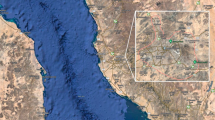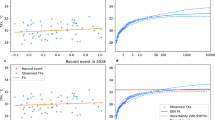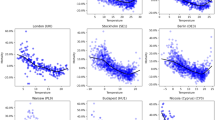Abstract
Warm temperatures adversely affect disease occurrence and death, in extreme conditions as well as when the temperature changes are more modest1,2. Therefore climate change, which is expected to affect both average temperatures and temperature variability, is likely to impact health even in temperate climates. Climate change risk assessment is enriched if there is information on vulnerability and resilience to effects of temperature. Some studies have analysed socio-demographic characteristics that make individuals vulnerable to adverse effects of temperature1,2,3,4. Less is known about community-level vulnerability. We used geo-coded mortality and environmental data and Bayesian spatial methods to conduct a national small-area analysis of the mortality effects of warm temperature for all 376 districts in England and Wales. In the most vulnerable districts, those in London and south/southeast England, odds of dying from cardiorespiratory causes increased by more than 10% for 1 °C warmer temperature, compared with virtually no effect in the most resilient districts, which were in the far north. A 2 °C warmer summer may result in 1,552 (95% credible interval 1,307–1,762) additional deaths, about one-half of which would occur in 95 districts. The findings enable risk and adaptation analyses to incorporate local vulnerability to warm temperature and to quantify inequality in its effects.
This is a preview of subscription content, access via your institution
Access options
Subscribe to this journal
Receive 12 print issues and online access
$209.00 per year
only $17.42 per issue
Buy this article
- Purchase on Springer Link
- Instant access to full article PDF
Prices may be subject to local taxes which are calculated during checkout



Similar content being viewed by others
References
Basu, R. High ambient temperature and mortality: A review of epidemiologic studies from 2001 to 2008. Environ. Health 8, 40 (2009).
Ye, X. et al. Ambient temperature and morbidity: A review of epidemiological evidence. Environ. Health Perspect. 120, 19–28 (2012).
Hajat, S., Kovats, R. S. & Lachowycz, K. Heat-related and cold-related deaths in England and Wales: Who is at risk? Occup. Environ. Med. 64, 93–100 (2007).
Zanobetti, A., O’Neill, M. S., Gronlund, C. J. & Schwartz, J. D. Summer temperature variability and long-term survival among elderly people with chronic disease. Proc. Natl Acad. Sci. USA 109, 6608–6613 (2012).
Robine, J. M. et al. Death toll exceeded 70,000 in Europe during the summer of 2003. Cr. Biol. 331, 171–178 (2008).
Garcia-Herrera, R., Diaz, J., Trigo, R. M., Luterbacher, J. & Fischer, E. M. A Review of the European summer heat wave of 2003. Crit. Rev. Env. Sci. Tec. 40, 267–306 (2010).
HM Government, The UK Climate Change Risk Assessment 2012 Evidence Report (DEFRA, 2012).
Reid, C. E. et al. Mapping community determinants of heat vulnerability. Environ. Health Persp. 117, 1730–1736 (2009).
Heltberg, R. & Bonch-Osmolovskiy, M. Mapping Vulnerability to Climate Change, Report No. WPS5554, (The World Bank, Policy Research Working Paper WPS5554, 2011).
Hahn, M. B., Riederer, A. M. & Foster, S. O. The livelihood vulnerability index: A pragmatic approach to assessing risks from climate variability and change—a case study in Mozambique. Glob. Environ. Change 19, 74–88 (2009).
Rey, G. et al. Heat exposure and socio-economic vulnerability as synergistic factors in heat-wave-related mortality. Eur. J. Epidemiol. 24, 495–502 (2009).
Chen, V. Y., Wu, P. C., Yang, T. C. & Su, H. J. Examining non-stationary effects of social determinants on cardiovascular mortality after cold surges in Taiwan. Sci. Total Environ. 408, 2042–2049 (2010).
Hondula, D. M. et al. Fine-scale spatial variability of heat-related mortality in Philadelphia County, USA, from 1983-2008: A case-series analysis. Environ. Health 11, 16 (2012).
Knowlton, K. et al. The 2006 California heat wave: Impacts on hospitalizations and emergency department visits. Environ. Health Perspect 117, 61–67 (2009).
Uejio, C. K. et al. Intra-urban societal vulnerability to extreme heat: The role of heat exposure and the built environment, socioeconomics, and neighborhood stability. Health Place 17, 498–507 (2011).
Xu, Y. et al. Differences on the effect of heat waves on mortality by sociodemographic and urban landscape characteristics. J. Epidemiol. Comm. Health 67, 519–525 (2013).
Brook, R. et al. Particulate matter air pollution and cardiovascular disease: An update to the scientific statement from the American Heart Association. Circulation 121, 2331–2378 (2010).
Anderson, B. G. & Bell, M. L. Weather-related mortality: How heat, cold, and heat waves affect mortality in the United States. Epidemiology 20, 205–213 (2009).
Gasparrini, A., Armstrong, B., Kovats, S. & Wilkinson, P. The effect of high temperatures on cause-specific mortality in England and Wales. Occup. Environ. Med. 69, 56–61 (2012).
Medina-Ramon, M. & Schwartz, J. Temperature, temperature extremes, and mortality: A study of acclimatisation and effect modification in 50 US cities. Occup. Environ. Med. 64, 827–833 (2007).
Smargiassi, A. et al. Variation of daily warm season mortality as a function of micro-urban heat islands. J. Epidemiol. Comm. Health 63, 659–664 (2009).
Hajat, S., Armstrong, B. G., Gouveia, N. & Wilkinson, P. Mortality displacement of heat-related deaths: A comparison of Delhi, Sao Paulo, and London. Epidemiology 16, 613–620 (2005).
Yu, W. et al. Time course of temperature effects on cardiovascular mortality in Brisbane, Australia. Heart 97, 1089–1093 (2011).
Gasparrini, A. & Armstrong, B. Reducing and meta-analysing estimates from distributed lag non-linear models. BMC Med. Res. Methodol. 13, 1 (2013).
Armstrong, B. G. et al. Association of mortality with high temperatures in a temperate climate: England and Wales. J. Epidemiol. Comm. Health 65, 340–345 (2011).
Perry, M. & Hollis, D. The generation of monthly gridded datasets for a range of climatic variables over the UK. Int. J. Climatol. 25, 1041–1054 (2005).
Hajat, S. & Kosatky, T. Heat-related mortality: A review and exploration of heterogeneity. J. Epidemiol. Comm. Health 64, 753–760 (2010).
O’Neill, M. S., Hajat, S., Zanobetti, A., Ramirez-Aguilar, M. & Schwartz, J. Impact of control for air pollution and respiratory epidemics on the estimated associations of temperature and daily mortality. Int. J. Biometeorol. 50, 121–129 (2005).
Richardson, E. A. & Mitchell, R. Gender differences in relationships between urban green space and health in the United Kingdom. Soc. Sci. Med. 71, 568–575 (2010).
Maclure, M. The case-crossover design: A method for studying transient effects on the risk of acute events. Am. J. Epidemiol. 133, 144–153 (1991).
Janes, H., Sheppard, L. & Lumley, T. Overlap bias in the case-crossover design, with application to air pollution exposures. Stat. Med. 24, 285–300 (2005).
Acknowledgements
We thank R. Burnett, K. De Hoogh, B. Hoskins, A. Majeed, C. Paciorek, A. Pope III, J. Schwartz and A. Zanobetti for discussions on data sources, methods and results. We thank P. Hambly and F. Al-Aidarous for mortality and ozone data, respectively. The UK Small Area Health Statistics Unit is a part of the MRC-PHE Centre for Environment and Health, which is financially supported by Public Health England and the UK Medical Research Council. M.E. is supported by an MRC Strategic Award. P.E. acknowledges support from the National Institute for Health Research (NIHR) Biomedical Research Centre at Imperial College Healthcare NHS Trust. P.E. is an NIHR senior investigator. The views expressed are those of the authors and not necessarily those of the NHS, the NIHR or the Department of Health.
Author information
Contributions
M.E., J.E.B. and P.E. designed the study concept. J.E.B., M.B. and M.E. developed the analytical approach. J.E.B. and D.F. collated and analysed gridded environmental data. J.E.B. analysed mortality effects. J.E.B. and M.E. wrote the first draft of the paper. All other authors contributed to interpretation of results and writing of the paper.
Ethics declarations
Competing interests
The authors declare no competing financial interests.
Supplementary information
Rights and permissions
About this article
Cite this article
Bennett, J., Blangiardo, M., Fecht, D. et al. Vulnerability to the mortality effects of warm temperature in the districts of England and Wales. Nature Clim Change 4, 269–273 (2014). https://doi.org/10.1038/nclimate2123
Received:
Accepted:
Published:
Issue Date:
DOI: https://doi.org/10.1038/nclimate2123
This article is cited by
-
Risk factors associated with heatwave mortality in Chinese adults over 65 years
Nature Medicine (2024)
-
A tutorial on the case time series design for small-area analysis
BMC Medical Research Methodology (2022)
-
Magnitude, demographics and dynamics of the effect of the first wave of the COVID-19 pandemic on all-cause mortality in 21 industrialized countries
Nature Medicine (2020)
-
Anomalously warm temperatures are associated with increased injury deaths
Nature Medicine (2020)
-
Socio-geographic disparity in cardiorespiratory mortality burden attributable to ambient temperature in the United States
Environmental Science and Pollution Research (2019)



